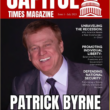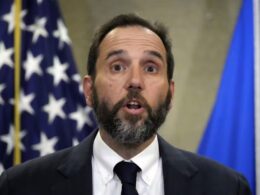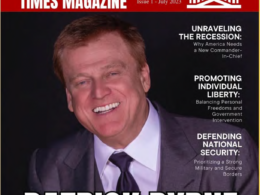Summary – Carol Remond recently wrote a defense of the meltdown of Rocker Partners (a.k.a. Copper River), her argument being, Rocker Partners shut down through no fault of their own, but because starting in September they were not able to break the law anymore.
Before publishing the following critique of Carol Remond’s recent article on Copper River, I contacted Carol for comment. Unlike Joe Nocera and Floyd Norris (both of the New York Times), who have at least had the integrity to defend their work, however haplessly, Carol refused any on-the-record comment on this subject. Thus she joins that tradition of journalistic worthies which includes Bethany McLean, Herb Greenberg, and Roddy Boyd, who refuse to defend their work. They can critique, but not engage, opine, but not defend: the sophomores of intellectual discourse.
Last week DowJones reporter and shill extraordinaire Carol Remond wrote a story, “Hedge Fund Copper River to Liquidate“, about the implosion of her hedge fund patron, Copper River (née Rocker Partners). Following a course charted by no lesser luminary than Roddy Boyd (cf. “Roddy Boyd Works It Likes He’s Paying the Rent“), Carol devotes the article to shameless apologetics that would make a congressman blush. Quelle surprise, Carol.
I am not a bayonette-the-wounded kind of guy (indeed, to investors in Copper River I send my condolences). But buried within Carol’s article is a critical admission that will be of interest both to readers of DeepCapture.com, and to those investors ill-starred enough to have stayed with Copper River/Rocker Partners through to its ugly and ignominious end. Carol states:
“Copper River held large short positions in some illiquid stocks when the Securities and Exchange Commission tightened the rules governing short selling…. By doing away with an exemption that was the backbone of a trading strategy that allowed funds to short stocks through the options market, the SEC effectively restricted their ability to maintain these positions.”
The “trading strategy” that was curtailed by the SEC “doing away with an exemption” that existed in the options market was the illegal strategy of naked shorting via rolling failed positions through the options market maker exception to Regulation SHO. Ms. Remond appears not to understand the SEC’s view of this illegal strategy. A fine paper by noted young economist John Welborn fleshed this out over a year ago (“Married Puts, Reverse Conversions and Abuse of the Options Market Maker Exception on the Chicago Stock Exchange”) . In it, he explained the requirement to locate stock, the exception to that requirement which Reg SHO makes for market makers, and the SEC’s view of the misuse of that exception. I will quote from John’s paper at length:
“THE OPTIONS MARKET MAKER EXCEPTION
“An FTD is commonly the result of a naked short sale (or a naked long sale) that does not settle, i.e. the shares sold short (or long) are never delivered to the buyer. In general, naked shorting is illegal. As the SEC’s Chairman Chris Cox said on July 12, 2006, “Selling short without having stock available for delivery, and intentionally failing to deliver stock within the standard three-day settlement period, is market manipulation that is clearly violative of the federal securities laws.”1 There are, however, a few of mechanisms through which naked short sales can be legally executed. One such mechanism is the “options market maker exception.”
“Current SEC rules state that a short seller, acting via a broker-dealer, need only ‘locate’ (as opposed to borrow) the stock prior to a short sale. Regulation SHO requires:
‘…A broker-dealer, prior to effecting a short sale in any equity security, to “locate” securities available for borrowing… Specifically, the rule prohibits a broker-dealer from accepting a short sale order in any equity security from another person, or effecting a short sale order for the broker-dealer’s own account unless the broker-dealer has (1) borrowed the security, or entered into an arrangement to borrow the security, or (2) has reasonable grounds to believe that the security can be borrowed so that it can be delivered on the date delivery is due. The locate must be made and documented prior to effecting a short sale, regardless of whether the seller’s short position may be closed out by purchasing securities the same day.’2 (Emphasis added.)
“In theory, stock markets are made more efficient by intermediaries who ‘make markets’ in order to smooth price and volume fluctuations.3 A market maker acts as a temporary counterparty that poses as buyer or seller in order to facilitate market liquidity. Ideally, market makers’ positions last minutes or hours; generally, positions are closed out at the end of each day. Large prime brokers make markets in both equities and options. Some broker-dealers, like Goldman Sachs and Merrill Lynch, clear and execute trades for options market makers…
“In the process of making markets, which requires hedging positions, market makers theoretically may need to sell stock they temporarily do not have. For this reason, Regulation SHO allowed market makers, ‘…[an] exception from the uniform “locate” requirement, as Rule 203(b)(2)(iii), for short sales executed by market makers, as defined in Section 3(a)(38) of the Exchange Act, including specialists and options market makers, but only in connection with bonafide market making activities (emphasis added).’4 Note that:
‘Bona-fide market making does not include activity that is related to speculative selling strategies or investment purposes of the broker-dealer and is disproportionate to the usual market making patterns or practices of the broker-dealer in that security. In addition, where a market maker posts continually at or near the best offer, but does not also post at or near the best bid, the market maker’s activities would not generally qualify as bona-fide market making for purposes of the exception. Further, bona-fide market making does not include transactions whereby a market maker enters into an arrangement with another broker-dealer or customer in an attempt to use the market maker’s exception for the purpose of avoiding compliance with Rule 203(b)(1) by the other broker-dealer or customer. 5 (Emphasis added.)’
“1 Christopher Cox, Chairman, SEC, “Opening Statements at the Commission Open Meeting,” July 12, 2006.
“2 SEC, Final Rule: Short Sales, Release No. 34-50103, Rule 203 – “Locate and Delivery Requirements for Short Sales,” July 28, 2004.
“3 Some view the market maker as an anachronism left over from the days when stock traded in 1/8th increments and paper certificates actually changed hands. Now, in the electronic age, stock trades in decimals and paper stock has been separated from the electronic claims of ownership on that stock (a process known as “dematerialization”).
“4 SEC Rule 203.
“5 Ibid, Section 1b, “Exceptions from the Locate Requirement: Bona-fide Market Making.”
Thus, Carol is explicitly stating, no doubt unwittingly, that the “backbone of a trading strategy” employed by David Rocker and Rocker Partners/Copper River was, in fact, abuse of an exception which the SEC had specifically deemed out-of-bounds.
Sloppy work, Carol: recommend you send for new instructions.
If this article concerns you, and you wish to help, then:
1) email it to a dozen friends;
2) go here for additional suggestions: “So You Say You Want a Revolution?“








No worries…SEC doesn’t seriously prosecute anyone for market manipulation, even when there is abundant evidence such as the trail Copper River has undoubtedly left behind.
Now if only Christopher Cox were subject to prosecution…
You know, I think the debate over the SEC’s incompetence re: Maddof is entertaining, but what I want to know is:
WEHERE IS THE MONEY….
If it’s no longer in the USA, let’s go get it…NOW
How can Maddof be free on bail for something of this magnitude UNLESS, he cut a deal…and IF he cut one, should not he have had to TELL where the MONEY IS???
Enough games….Where The F is the money?????????
Apparently illegal trading strategies are of no interest to the SEC. Just like Madoff’s violation of trading rules in 2006 that were identified but not pursued by the SEC for whatever reason.
I suggest we all contact [email protected] to complain about lax enforcement of securities laws. The SEC Inspector General needs to do something.
This idea has been floated a few times. If implemented on mass, I think it would bring the system to its knees and bankrupt the bad guys.
1. Investor group acquires an extremely profitable private company.
2. Investor group buys 100% of the outstanding shares of a heavily shorted issuer. It doesn’t matter if the business was a scam or not. What you are looking for is a shell where there are lots of unsettled fails. A CMKX type company would be perfect. It could be a delisted company – just get it to qualify with the new business and relist it, but don’t roll it back. All those fails and obligations for the fails are still outstanding. They don’t go away just because it was delisted. As long as the company isn’t delinquent with the state, it can be relisted.
3. Issue one share to purchase the private company. It doesn’t matter how many shares you issue as you own 100% of the shell and 100% of the private company.
4. Start paying cash dividends. The counterfeiters have to match every dividend, dolllar for dollar. Let’s say the fails were hundred times the outstanding because it was cellar boxed at .001.
Then for every dollar the company pays out in dividend, the counterfeiters have to pay out $100. It becomes a cash machine. The stock would likely rise as they desperately try to cover, but don’t sell them any real shares. They can’t get out of the position and have no choice to keep paying the $100 until they go bankrupt.
The money they are paying out goes out to the people that they gave IOU’s to, not the investor group, so there is no issue with manipulation. It’s only karma to make them pay dividends to the people they owe real shares to. In reality, the investors group might only be able to buy 99% to stay compliant with rules about floats, etc., but the basic idea is the same.
Rinse and repeat with other shells and other private companies.
No surprise. What would you have expected Charlie McCarthy to have said about Edgar Bergen’s hedge fund going under?
Only difference here was I don’t think Copper River’s manipulative hand was up this puppet’s back. Think it was about a foot lower.
A little off topic, but I believe you got some dap on CNBC today in regards to the Aguirre case, Dr. Byrne. No names were mentioned, but plenty of innuendo, on that bastion of journalistic integrity.
I don’t understand, for the life of me how $2.29 trillion out of $10.3 trillion in government debt can fail to deliver. How can I buy what I think is super safe, AAA debt, even taking a negative interest rate and receive an IOU instead?
Why don’t these guys get arrested for counterfeiting? Has anyone contacted the secret service?
http://www.investmentnews.com/apps/pbcs.dll/article?AID=/20081019/REG/310209975
The credit crisis is causing a growing number of delivery failures with Treasury securities.
The latest data from the Federal Reserve Bank of New York showed that cumulative failures hit a record $2.29 trillion as of Oct. 1. The federal settlement period is T+1 (trade date plus one day).
The outstanding U.S. public debt is $10.3 trillion.
“Current [fail] levels are at historic levels,” said Rob Toomey, managing director of the Securities Industry and Financial Markets Association’s funding and government and agency securities divisions. “There’s been significant flight to quality” with the market turmoil, he said.
With the strong demand for Treasury securities, “some of the entities that bought Treasuries are not making them available in the [repurchase] market, which is the traditional way to get them,” Mr. Toomey said.
Unlike some past bouts with high failure rates that involved particular bond issues, the current high fails involve all types of maturities, he said.
This month, New York- and Washington-based SIFMA came out with a set of best practices to reduce failed deliveries.
This year, the New York Fed revised its own Treasury market trading guidelines. Its guidelines, originally released last year, warned that short-sellers “should make deliveries in good faith.”
Is Madoff a whistleblower?
I don’t even think you can call whatever it is that they do “intellectual discourse”.
Kevin, it’s absurd and evokes images of brokers taking fake t bills in exchange for fake shares. What this country really needs is a new $10,000 note, which is what the Franklin would be worth if it had kept up with inflation. A 5 cent soda counter luncheon (burger, fries, ‘coke’) yesterday cost me $6 at some place called McDonald’s.
yt,
Herb Wells
Cramer Does Patrick. Too, too funny…………..
http://www.cnbc.com/id/15840232?video=966337239&play=1
From Investorsvillage!! You’ve got to see this.
Let’s be clear about REG SHO having a loophole that allows naked short selling:
1. It is a true statement, REG SHO does authorize naked short selling. However,
2. Only within the settlement cycle, which is generally inside 3 days.
Fails outside the settlement cycle (rule 15c6-1) are not authorized by anything in REG SHO by anyone and thus all fails are illegal.
So we should be clear as a bell and differentiate between
1. Legal naked short selling, withing the settlement cycle
2. Illegal naked short selling, outside and beyond the settlement cycle
3. Fails to Deliver, always illegal
If you’re going to steal, steal a lot.
Think about this a little closer.
The SEC investigated David Rocker and Rocker Partners the same time they investigated Gradient and Overstock.com. Eventually the SEC gave all three a no-action response but it took the SEC an extra few years to give Overstock theirs as opposed to Rocker and Gradient.
What have we learned since then?
Gradient settled with Overstock.com and admitted to the error of their ways and did so publicly. Most likely there is something the PR did not tell us but for all appearances teh settlement proved the SEC was wrong in giving up the no-action letter.
This Remond article likewise exposes the fact that Rocker could not make money unless they engaged in a scheme (strategy) that was illegal. So why didn’t the SEC find this out when they investigated Rocker and his trading records?
Doesn’t this all go to show that the SEC is incapable of identifying fraud even when it is handed to them? The Madoff scandal is now proving the SEC can audit the books of a Ponzi scheme and still give it a clean bill of health.
Repost:
It seems the bad guys are the same ones going bankrupt and the same ones writing anti SHO letters.
Letter from Madoff on SHO.
http://www.sec.gov/rules/proposed/s72303/s72303-284.pdf
Private Madoff conference call on SHO with SEC.
http://www.sec.gov/rules/proposed/s72303/s72303-431.pdf
http://www.sec.gov/comments/s7-12-06/s71206-149.pdf
As what has become a pattern of the SEC, the investing public is not given equal face time to openly discuss matters/analysis with the Commission as is frequently being afforded to the institutions the Commission is responsible for regulating; a double standard that puts in question the Commissions true motives. [Ref: The SEC’s Documented Memorandums to meetings held during the inception of Regulation SHO with the Securities Industry Association, National Service Clearing Corporation, Bear Stearns, Madoff Investment Securities, Hill Thompson, Citigroup Global Markets, and LEK Securities Corp http://www.sec.gov/rules/proposed/s72303.shtml
Once considered a radical practice but only a minor source of inefficiency, payments for
order flow – agreements by which dealers offer monetary rewards or other non-pecuniary
services to brokers in exchange for the routing of retail market bid or ask offers116 — have
become a core regulatory concern. The controversy became prominent in 1993, when Madoff
Investments mysteriously garnered 10% of NYSE-listed volume through a legal “kickback”
scheme that permitted brokers to increase personal revenues without obtaining the consent of
their clients.117
http://www.sec.gov/rules/proposed/s71004/jdmt011405.pdf
“The Madoff Exception”
http://www.chx.com/content/Participant_Information/Downloadable_Docs/MarketRegulation/1_InformationMemoranda/2004/MR_04_26_Regulation_SHO.pdf
Regulation SHO, Rule 200 – Order Marking and Ownership
SEC Rule 200(g) defines the ownership of securities with regard to short sale transactions previously enumerated under SEC Rules 3b-3 and 10a-1(d). Pursuant to the provisions of SEC Rule 200, all sales of equity securities must be marked “long”, “short”, or “short exempt”.
Orders can be marked “long” only when the seller owns the security being sold, and such security is in the physical possession or control of the broker-dealer, or it is reasonably expected that the security will be in the physical possession or control of the broker-dealer prior to settlement.
Orders must be marked “short exempt” if the seller is entitled to rely upon any exception to the tick test under SEC Rule 10a-1 and Exchange Article IX, Rule 17. Short sale transactions involving a specialist pursuant to the so-called “Madoff” exception or the equalizing exemption under SEC Rule 10a-1(e)(5) (sales by specialist or market maker on a zero-minus tick), however, need not be marked as “short exempt.” Orders marked “short exempt” must also comply with the stock locate requirements detailed in SEC Rule 203 below, unless some exception applies…
Patchie,
INCAPABLE or CULPABLE ?
“we’ve” been sending the SEC all the evidence they’ve needed since 2000, and they have know full well about Fails to deliver,naked shorting, and the manipulation since the mid 90’s.
The SEC should be revamped, pereiod.
I’ve been saying “Cash is King” for many years now, and that idea of buying a heavily shorted stock, like CMKX, and then handing out a small cash dividend would without a doubt uncover the worst of the miscreants. Maybe even the Sith Lord. A cash divy of even .005 would BK the Basties in round one. 🙂
Pontiyak, the thing I like about it is they wouldn’t be able to get out as there are either no shares or virtually no shares in the float. They’d be trapped with their counterfeit obligations.
Let’s say I am the sole owner of a private company and owner of 100% of the float of a heavily shorted shell. The private company was paying me $5 million per year.
I have the shell purchase the private company for one share and pay out the $5 million in dividends and I still get the exact same $5 million back I was getting when it was private as I own 100% of the outstanding.
The difference, is all the other IOU shareholders also get paid. If there was 100 times the float outstanding naked, then shorty would have to write a check for $500 million each and every year and watch helplessly as the share price and his margin requirement rises until he pops.
There are lots of shells like this. Look for the companies that traded at .001 on the pinks.
Rinse and repeat and suddenly $500 million seems like a lot of money as all those delisted companies come back to life with new businesses to extract revenge from the bad guys.
This is why keeping a site like this up is important. It documents all the ‘notices’ to the SEC and we know the fine folks there read it.